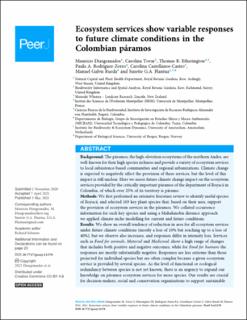| dc.description.abstract | Background: The páramos, the high-elevation ecosystems of the northern Andes, are well-known for their high species richness and provide a variety of ecosystem services to local subsistence-based communities and regional urbanizations. Climate change is expected to negatively affect the provision of these services, but the level of this impact is still unclear. Here we assess future climate change impact on the ecosystem services provided by the critically important páramos of the department of Boyacá in Colombia, of which over 25% of its territory is páramo.
Methods: We first performed an extensive literature review to identify useful species of Boyacá, and selected 103 key plant species that, based on their uses, support the provision of ecosystem services in the páramos. We collated occurrence information for each key species and using a Mahalanobis distance approach we applied climate niche modelling for current and future conditions.
Results: We show an overall tendency of reduction in area for all ecosystem services under future climate conditions (mostly a loss of 10% but reaching up to a loss of 40%), but we observe also increases, and responses differ in intensity loss. Services such as Food for animals, Material and Medicinal, show a high range of changes that includes both positive and negative outcomes, while for Food for humans the responses are mostly substantially negative. Responses are less extreme than those projected for individual species but are often complex because a given ecosystem service is provided by several species. As the level of functional or ecological redundancy between species is not yet known, there is an urgency to expand our knowledge on páramos ecosystem services for more species. Our results are crucial for decision-makers, social and conservation organizations to support sustainable strategies to monitor and mitigate the potential consequences of climate change for human livelihoods in mountainous settings. | en_US |

